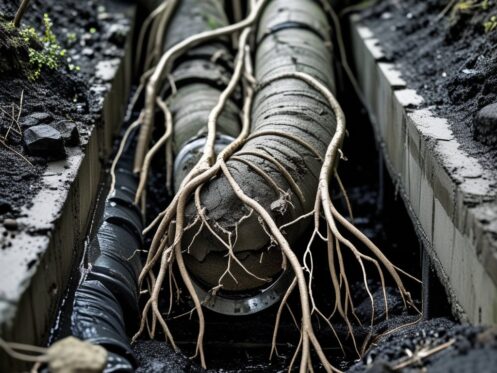Tree roots can cause big problems for your sewer lines by growing into pipes and causing blockages or breaks. To prevent this damage, plant trees at least 10 feet away from your sewer lines and consider installing root barriers to keep roots away from your pipes. Removing trees with aggressive roots near your sewer can also help protect your plumbing.
Splash Plumbing has helped plenty of folks in Anaheim keep their sewer lines safe and clear with regular inspections and prevention tips.
Understanding How Tree Roots Affect Sewer Lines
Tree roots chase after moisture and nutrients. Old or damaged sewer lines leak water, which attracts roots. If you don’t catch it early, roots can block or break pipes.
Why Tree Roots Invade Sewer Pipes
Roots naturally seek water. Sewer pipes often have tiny cracks or loose joints that let moisture escape. Roots sense this and grow right into those openings.
Once inside, roots keep growing, filling the pipe and causing clogs or even breaks. Older pipes are easier targets than newer ones.
Keeping roots out is a must if you want to avoid plumbing disasters.
Common Signs of Root Intrusion
You might notice slow drains or frequent backups. These are usually the first signs roots have found their way in.
Other hints: strange smells near your sewer line, or soggy spots in your yard above the pipe. Roots can cause leaks, letting water escape into the soil.
Cracks in your sewer cleanout or gurgling sounds when flushing also suggest root trouble.
Routine inspections—like video scans—can catch root problems early.
Types of Sewer Lines Most at Risk
Older clay, cast iron, and concrete pipes crack and loosen over time, making them easy for roots to invade.
Plastic pipes like PVC or ABS usually resist roots if installed and maintained properly.
If you’ve got big trees or shrubs near your lines, the risk goes up. Pipes close to surface roots need extra protection.
Root barriers and careful planting help, but regular maintenance matters no matter what type of pipe you have.
Selecting the Right Trees for Your Property
Choosing the right trees near your sewer lines can save you headaches and money. Knowing which species to avoid, how far to plant them, and their growth habits helps keep your plumbing safe.
Tree Species with Aggressive Roots
Some trees have roots that spread fast and forcefully. Willows, poplars, and silver maples are notorious for invading pipes. Their roots squeeze into even tiny cracks.
Instead, try trees with gentler roots like dogwood, redbud, or Japanese maple. These grow more slowly and don’t spread as far. If you want something bigger, pick trees known for less aggressive roots to lower your risk of sewer damage.
Safe Distance to Plant Trees from Sewer Lines
Planting trees far enough from your sewer line is crucial. Experts say at least 20 feet away, and for bigger trees, 30 feet or more is safer.
If your yard is tight, stick to smaller trees or use root barriers. Before planting, figure out exactly where your sewer lines are—digging a little now can prevent a lot of trouble later. Splash Plumbing can help locate your lines for safe planting.
Tree Size and Root Growth Patterns
Bigger trees mean bigger roots, and those roots can stretch far beyond the canopy. Young trees might seem harmless, but as they mature, roots get stronger and spread wider.
Some trees have shallow, wide roots; others grow deeper. Knowing this helps you decide where to plant and what to plant. Root barriers or trees with deeper, less invasive roots keep your plumbing safe without sacrificing your landscaping.
Preventive Measures to Protect Sewer Lines
You’ve got a few good ways to keep roots out of your pipes—physical barriers, better pipe materials, or safe chemicals.
Installing Root Barriers
Root barriers are tough plastic or metal sheets you bury near sewer lines. They block roots from reaching your pipes but let them grow elsewhere. Install them at least 10 feet from the sewer line for best results.
If you’re handy, you can do it yourself, but hiring a pro like Splash Plumbing guarantees it’s done right. Barriers work especially well if you’ve got big or fast-growing trees close by. They last a long time and don’t hurt your trees.
Using Root-Resistant Pipe Materials
Pipes made from root-resistant materials can stop problems before they start. PVC and HDPE pipes have tight joints and smooth surfaces that roots can’t easily get into.
If your lines are old clay or cast iron, switching to modern pipes can save you money down the road. The smooth inside keeps roots from latching on, so clogs are less likely. If you’re replacing pipes, ask your plumber about these materials—they last longer and hold up better.
Applying Chemical Root Inhibitors
Chemical root inhibitors are products that stop roots from growing inside your pipes. You pour them into the line, and they kill roots without harming the whole tree.
Usually, you apply these every one to three years. They’re handy if you want to avoid digging or replacing pipes right away. Just follow the instructions or have a pro handle it. These inhibitors keep your pipes clear and help you avoid root blockages.
Routine Maintenance and Inspection
Keeping your sewer lines free of roots takes regular attention. You’ve got to check your pipes often and get expert help when needed.
Scheduling Regular Sewer Line Inspections
Get your sewer lines inspected at least once a year. Pros use a camera to look inside without digging anything up. This finds root growth before it turns into a serious problem.
Catching roots early lets you fix things with less hassle and cost. Regular inspections prevent backups and major repairs.
Professional Tree Root Management Services
If you’re already dealing with roots or want to avoid them, call a professional for root management. Splash Plumbing and others use tools like hydro jetting—that’s high-pressure water blasting away roots and debris.
Sometimes they’ll install root barriers or give advice on where to plant trees. This guidance keeps your pipes safe and saves money down the line.
What to Do If Roots Have Already Invaded
If roots are already in your sewer lines, act fast. You have a few ways to clear them out without digging up your yard, but sometimes you’ll need professional help.
Non-Invasive Root Removal Methods
You can try a root-cutting tool (like an auger or rooter) to slice through roots inside the pipe.
Chemical root killers made for sewer pipes work too. They kill roots in the line but won’t hurt your landscaping—just follow directions.
Hydro jetting uses high-pressure water to blast roots and debris out. It’s powerful enough to clear roots but safe for your pipes if done properly.
These methods help when roots are just starting to invade or aren’t too thick yet.
When to Call a Plumbing Specialist
If roots keep coming back or you’ve got serious clogs or pipe damage, call a pro. They’ll use cameras to inspect your pipes and find exactly where roots have broken in.
Plumbers can remove roots with motorized cutters or hydro jetters. If things are really bad, they might suggest replacing pipe sections.
If you’re near Anaheim, Splash Plumbing knows how to handle these problems without unnecessary digging. Getting a specialist in early saves you from bigger headaches later.
Long-Term Solutions and Landscape Planning
Keeping tree roots out of your sewer lines takes more than quick fixes. Smart planning and a few upgrades go a long way.
Upgrading to Modern Sewer Systems
Old pipes crack and let roots inside. Upgrading to PVC or HDPE pipes gives you stronger, smoother sewer lines. Roots have a tough time getting in.
Some modern pipes have root-resistant coatings and tighter joints. They last longer, and while the upgrade costs more upfront, it saves you money on repairs.
If you’re in Anaheim, Splash Plumbing can check your pipes and tell you if upgrading makes sense. It’s a solid investment in your property’s value and peace of mind.
Creating a Root Management Plan
A root management plan helps you control how trees grow near your sewer lines. Start by spotting trees with aggressive roots—willows, maples, poplars—and keep them far from pipes.
Install root barriers made of plastic or metal underground. These barriers guide roots away from your lines.
Regular maintenance matters. Schedule video inspections every few years to catch root invasion early. Trim roots near problem spots if needed.
Splash Plumbing can help set up and maintain a plan like this, so you’re not caught off guard.
Neighborhood and Community Prevention Tips
You and your neighbors can work together to protect sewer lines from tree roots. Chat with your community about smart tree planting to stop issues before they start.
Plant trees at least 10 to 20 feet from sewer lines. That distance gives roots less chance to reach the pipes. Pass this info along—everyone benefits from fewer plumbing emergencies.
Encourage your community to install root barriers. These barriers keep roots from wandering toward pipes.
If everyone gets their sewer lines checked yearly, you’ll catch problems early. Use video inspections or call a plumber if you’re not sure.
Anaheim folks can call Splash Plumbing for inspections and repairs. Working with pros makes it easier to prevent root damage.
Neighborhood teamwork really does help. Sharing knowledge and looking out for each other protects everyone’s pipes and wallets.
Frequently Asked Questions
Tree roots can cause serious damage to your sewer lines if you’re not careful. Understanding how to plant, inspect, and maintain your property helps keep your pipes safe.
What are the best practices for planting trees near sewer lines?
Try to plant trees at least 20 to 30 feet from sewer lines if you can manage it. Go for trees with shallow, less aggressive roots—those are much less likely to cause trouble. Before you dig, definitely check where your pipes run on your property. It’s a hassle if you hit one.
Can root barriers be effective in protecting sewer lines from tree roots?
Root barriers can really help. They sort of nudge roots away from pipes, which lowers the odds of roots sneaking into your sewer line. Honestly, setting up a barrier early is way easier than dealing with busted pipes later.
How often should I inspect my sewer lines for root intrusion?
If you’ve got trees anywhere near your sewer lines, it’s smart to get things checked every year or two. Catching root issues early can spare you from some seriously expensive repairs.
Are there any particular types of trees I should avoid planting near sewer lines?
Yeah, steer clear of trees with aggressive, deep roots—willows, poplars, eucalyptus, that sort of thing. Those guys are notorious for breaking into pipes just to find water.
What signs should I look out for that indicate roots are affecting my sewer lines?
Watch for slow drains, weird gurgling noises, nasty smells, or clogs that keep coming back. Any of these could mean roots are creeping into your pipes and causing blockages. Here’s a quick list of common signs if you want more details.
Can regular maintenance help prevent root damage to sewer pipes?
Absolutely—if you keep up with things like video inspections or the occasional hydro jetting, your pipes stand a much better chance against roots sneaking in. It’s not just about avoiding blockages; you’re sidestepping those nightmare repair bills too.
If you’re around Anaheim, CA, the folks at Splash Plumbing can swing by for inspections or repairs to help keep those sewer lines in decent shape.












